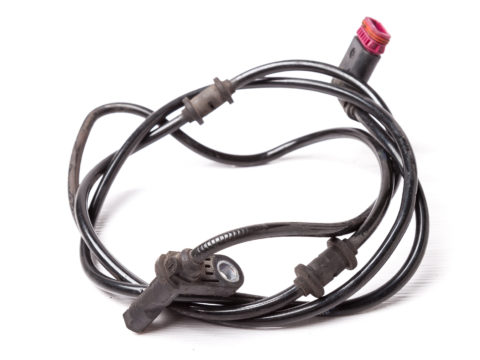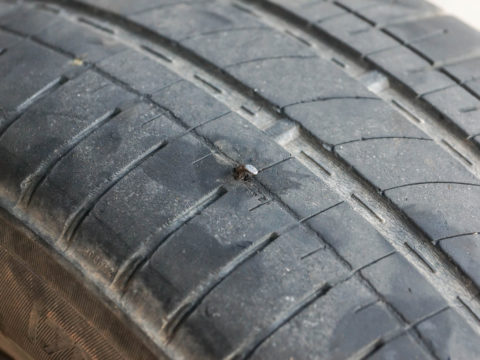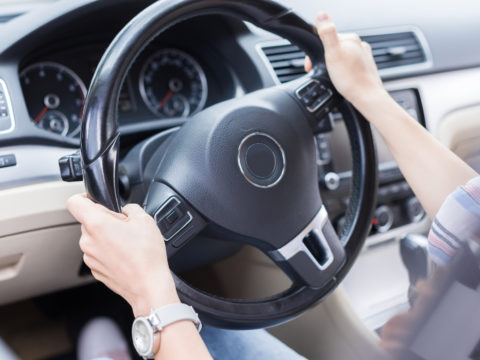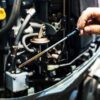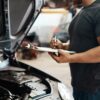If you drive a front-wheel drive, all-wheel drive, or four-wheel drive vehicle, then your car’s got a front differential.
If you’re experiencing concerning noises, are having drivability issues that you think may be related to your front differential, then read on to learn about this critical component.
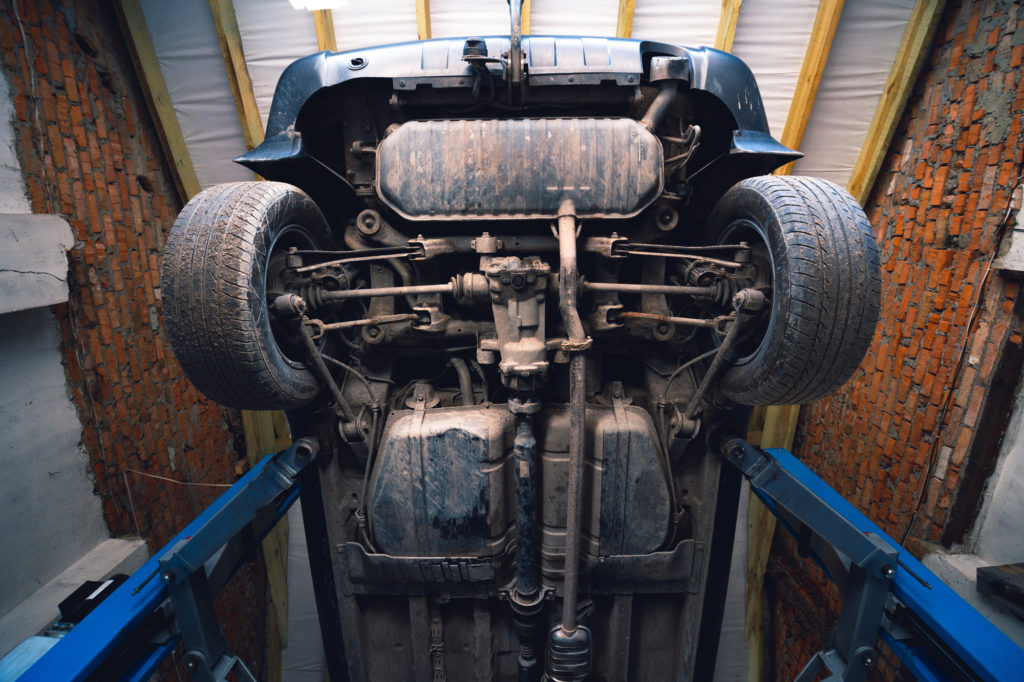
Contents
What Is a Front Differential?
The front differential is a set of gears that comprises a crucial part of your front-wheel, all-wheel drive, and four-wheel-drive vehicle.
You may also see a front differential attached to the side of a transmission described as a “transaxle.”
Where Is it Located in a Car?
The front differential on a front-wheel drive and all-wheel drive vehicle is located directly between the front wheel axles in the center of the car’s undercarriage.
It is attached to the transmission in a unit called a transaxle.
On a four-wheel drive vehicle, the front differential is attached to the side of the engine and runs to the front drive shaft, which in turn runs to the transfer case.
How Do They Work?
Front differentials distribute engine power, rotational speed, and torque to the front wheels.
Importantly, the front differential allows the front wheels to turn at different speeds, ensuring balance and stability while turning.
In all-wheel drive and four-wheel drive vehicles, the front and rear (and sometimes center) differentials help improve traction in four wheels.
There are four main types of differentials with varying internal engineering, performance, and abilities.
Open Differential
An open front differential is the simplest form of a differential. It provides power, torque, and individualized rotating speed to the front wheels.
With an open differential, a minimum amount of traction is maintained if one wheel loses traction by lowering power to the other wheel.
While the open differential has fallen out of favor for higher performance, higher traction-providing differentials, it can still be found in some economy cars.
Locking Differential
Locking differentials are the only type of differential that don’t allow wheels to spin at different speeds.
This differential works for off-roading and technical driving rather than everyday driving.
The advantage of locking differentials for off-roading is that power is maintained to the wheels even if one or both tires lose traction.
Locking differentials can help off-roading vehicles rock crawl and move through muddy or otherwise non-grippy terrain.
Limited-Slip Differential
A limited-slip front differential can be found on front-wheel, all-wheel drive, and four-wheel drive vehicles.
The limited slip differential is typically considered the best model of differential for everyday driving across many types of vehicles.
Essentially, a limited-slip differential operates the same as an open differential until a wheel or wheel starts to slip. At this point, the differential will automatically lock, helping to maintain power and traction in a dicey driving scenario.
Torque-vectoring
Torque-vectoring differentials are popular among enthusiasts of sports cars and technical driving.
This type of differential is found on modern, high-dollar sport lexuses and BMWs.
It uses additional gears within the differential to further individualize the amount of torque sent to a specific wheel, enhancing performance, handling, and control around turns and curves.
Functions of the Front Differential
The front differential provides several crucial functions for front-wheel drive, all-wheel drive, and four-wheel drive vehicles.
Below are listed the top four most important functions of the front differential.
Power, Torque, and Rotational Speed
The front differential provides engine torque, rotational speed, and power (torque times rotational speed) to the front wheels.
Enhanced Handling and Control
The front differential provides enhanced handling and control around turns. Your vehicle may lose stability around a turn and wreck without this function.
Limited-Slip Rotational Energy
Limited slip differentials provide the additional function of allowing unequal distribution of torque once slipping occurs, unlike open differentials.
For instance, if a vehicle gets stuck in the mud and one wheel starts spinning, a limited slip differential will allow the non-spinning wheel to maintain rotational energy.
Allows Wheels to Spin at Different Speeds
The front differential allows the front wheels to spin at different speeds while providing equal torque to the wheels.
Symptoms of Bad Front Differentials
Several symptoms can accompany a failing differential. Below are six of the most common symptoms of a bad front differential.
Noises
A bad front differential can make a noticeable sound that emanates from underneath the front of your vehicle.
It can be a whirring, howling, grinding, or whining noise and often indicates a problem with the gears within the differential. These noises can be particularly prominent when turning.
Burning Smell
A burning smell coming from the undercarriage of your car can be a sign that the differential oil is either too low, dirty, or contaminated.
The differential must have the correct amount of clean oil to lubricate the gears and ensure the proper functioning of the components and differential unit as a whole.
Vibrations
If your front differential fails, you may notice drivability issues such as vibrating and rough driving.
These vibrations can be caused by not having enough differential fluid or by water leaking into the unit.
Uneven or Excessive Tire Wear
You may notice uneven or excessive wear on your front tires if your front differential is failing.
If your front differential isn’t effectively distributing torque to your front wheels, the tires will experience increased friction because it’s not spinning as freely as needed.
While uneven tread can be a symptom of several varying issues, assessing the tires can help diagnose a possibly faulty front differential.
Difficulty Handling
If you’re experiencing difficulty handling and controlling your vehicle around turns, then you may want to have your front differential looked over by a certified mechanic.
This symptom is not one to ignore as it can lead to a significant accident should the vehicle fail to maintain control around a turn.
Leaking Differential Fluid
Your differential may be failing due to a differential fluid leak.
If you’re noticing problems that you suspect to be linked to your differential, then go ahead and check underneath your vehicle for a leak coming from this component.
You can also look at the color of the fluid drilling from the front differential to determine if the fluid is dirty or contaminated.
Should You Drive Your Car with Bad Front Differentials?
If your front differential is failing, you may be wondering if it’s safe to drive your vehicle.
Because the front differential controls the torque, power, and rotational speed of the front wheels, it is not recommended to drive on a bad front differential.
Doing so could result in a car wreck, especially if you lose control around a turn or curve.
If you suspect that your front differential is failing, the best thing to do is to get the vehicle to a certified mechanic as soon as possible.
If you’re experiencing drivability issues with your vehicle, then you may want to have your car towed to an experienced mechanic.
Suppose this getting your car towed is not a viable option. In that case, the next best course is to drive your vehicle slowly and very carefully to your nearest qualified mechanic, taking extra precautions around curves.
How Much Does It Cost to Repair Bad Front-Wheel Differentials?
Repairing or replacing a bad front differential can vary significantly in cost.
A simple repair of a straightforward problem could cost around $300, but a full overhaul or replacement of a high-end front differential could cost more than $2,000.
The costs of this repair are heavily dependent on make, model, and year of your vehicle and the type of front differential your car has.
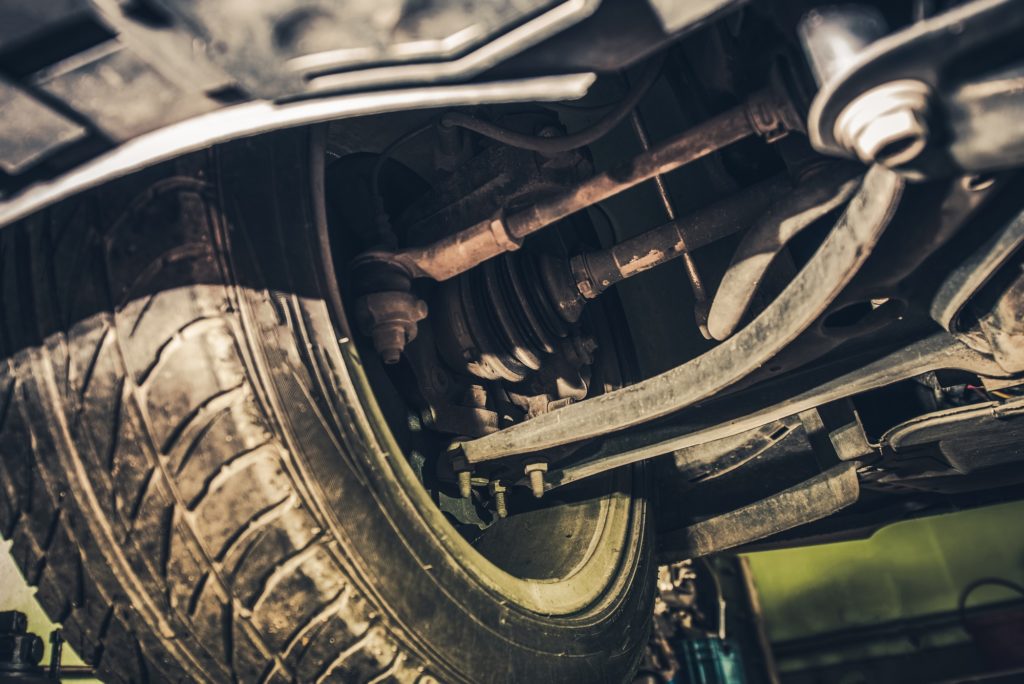
Where to Buy Front Differential Parts
Quality differential fluid gets sold at many common auto parts stores and specialty stores.
Additionally, many auto parts stores either carry or will order replacement front differential parts such as front differential pinion sets, axle shafts, housings and carriers, seals and bearings, gear kits, rings, etc.
Because the front differential is part of a vehicle’s driveline, quality differential parts can be found at stores that cater specifically to a vehicle’s driveline.
Parts can be ordered online as well at general auto parts sites and specialty driveline websites.
FAQs
Vehicle components can be confusing, so to provide more clarity, we’ve listed below five frequently asked questions about front differentials.
Do all cars have rear and front differentials?
No, not all cars have both rear and front differentials. Rear-wheel vehicles only have rear differentials. Front-wheel vehicles only have front differentials.
Do all-wheel-drive cars have front differentials?
Yes, all-wheel drive and four-wheel drive vehicles have front differentials. These vehicles must have front and rear differentials to maintain a higher degree of traction in all four wheels.
Are front and rear differentials the same?
Front and rear differentials serve the same purpose of providing torque, power, and rotational speed control to the wheels but in separate areas of the vehicle.
Can a front differential be rebuilt?
Yes, a front differential can be rebuilt. Whether someone opts to rebuild or replace a bad front differential usually depends on the work that needs doing and the cost comparisons of replacement versus rebuild.
Conclusion
The front differential is a critical component of front-wheel, all-wheel, and four-wheel drive vehicles that provides both performance and safety to your driving experience.
As the repairs for a faulty front differential can be rather costly, it is imperative to ensure that your differential fluid is clean and full to ensure the proper functioning of this crucial component.
Keep in mind the various symptoms of a failing front differential, and take the vehicle to a certified mechanic as soon as you suspect an issue.
Catching a problem early can prevent costly repairs or replacements and helps ensure the safety of the driver and passengers.


